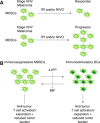Myeloid-derived suppressor cells-a new therapeutic target to overcome resistance to cancer immunotherapy
- PMID: 28546500
- PMCID: PMC6608049
- DOI: 10.1189/jlb.5VMR1116-458RRR
Myeloid-derived suppressor cells-a new therapeutic target to overcome resistance to cancer immunotherapy
Abstract
Myeloid-derived suppressor cells (MDSCs) are a heterogeneous population of immature myeloid cells that accumulate during pathologic conditions, such as cancer. Patients diagnosed with advanced metastatic cancers have an average survival of 12-24 mo, a survival time that hasn't changed significantly in the past 30 yr. Despite some encouraging improvements in response rates and overall survival in patients receiving immunotherapies, such as immune checkpoint inhibitors, most patients will ultimately progress. MDSCs contribute to immunotherapeutic resistance by actively inhibiting antitumor T cell proliferation and cytotoxic activity as well as by promoting expansion of protumorigenic T regulatory cells, thereby, dampening the host immune responses against the tumor. In addition, MDSCs promote angiogenesis, tumor invasion, and metastasis. Thus, MDSCs are potential therapeutic targets in cases of multiple cancers. This review focuses on the phenotypic and functional characteristics of MDSCs and provides an overview of the mono- and combinatorial-therapeutic strategies that target MDSCs with an objective of enhancing the efficacy of cancer immunotherapies.
Keywords: MDSC; MIF; PFKFB3; immune checkpoint inhibitors; immune suppression; tumor immunology.
© Society for Leukocyte Biology.
Figures



Similar articles
-
The New Era of Cancer Immunotherapy: Targeting Myeloid-Derived Suppressor Cells to Overcome Immune Evasion.Front Immunol. 2020 Jul 30;11:1680. doi: 10.3389/fimmu.2020.01680. eCollection 2020. Front Immunol. 2020. PMID: 32849585 Free PMC article. Review.
-
Suppression of T cells by myeloid-derived suppressor cells in cancer.Hum Immunol. 2017 Feb;78(2):113-119. doi: 10.1016/j.humimm.2016.12.001. Epub 2016 Dec 7. Hum Immunol. 2017. PMID: 27939507 Review.
-
Immature myeloid cells in the tumor microenvironment: Implications for immunotherapy.Clin Immunol. 2018 Apr;189:34-42. doi: 10.1016/j.clim.2016.10.008. Epub 2016 Oct 21. Clin Immunol. 2018. PMID: 27777083 Free PMC article. Review.
-
Functional Diversity of Myeloid-Derived Suppressor Cells: The Multitasking Hydra of Cancer.J Immunol. 2019 Sep 1;203(5):1095-1103. doi: 10.4049/jimmunol.1900500. J Immunol. 2019. PMID: 31427398 Free PMC article. Review.
-
Autophagy orchestrates the regulatory program of tumor-associated myeloid-derived suppressor cells.J Clin Invest. 2018 Aug 31;128(9):3840-3852. doi: 10.1172/JCI120888. Epub 2018 Aug 6. J Clin Invest. 2018. PMID: 29920188 Free PMC article.
Cited by
-
Comprehensive Multiomics Analysis Identified IQGAP3 as a Potential Prognostic Marker in Pan-Cancer.Dis Markers. 2022 Sep 16;2022:4822964. doi: 10.1155/2022/4822964. eCollection 2022. Dis Markers. 2022. PMID: 36164370 Free PMC article.
-
Role of myeloid-derived suppressor cells in tumor recurrence.Cancer Metastasis Rev. 2023 Mar;42(1):113-142. doi: 10.1007/s10555-023-10079-1. Epub 2023 Jan 14. Cancer Metastasis Rev. 2023. PMID: 36640224 Free PMC article. Review.
-
Myeloid-Derived Suppressor Cells Specifically Suppress IFN-γ Production and Antitumor Cytotoxic Activity of Vδ2 T Cells.Front Immunol. 2018 Jun 6;9:1271. doi: 10.3389/fimmu.2018.01271. eCollection 2018. Front Immunol. 2018. PMID: 29928279 Free PMC article.
-
Metronomic chemotherapy: bridging theory to clinical application in canine and feline oncology.Front Vet Sci. 2024 Jun 6;11:1397376. doi: 10.3389/fvets.2024.1397376. eCollection 2024. Front Vet Sci. 2024. PMID: 38903691 Free PMC article. Review.
-
Role of Nutrients Regulating Myeloid Derived Suppressor Cells in Cancer: A Scoping Review.Curr Issues Mol Biol. 2024 Aug 23;46(9):9286-9297. doi: 10.3390/cimb46090549. Curr Issues Mol Biol. 2024. PMID: 39329901 Free PMC article.
References
-
- Hodi, F. S. , O'Day, S. J. , McDermott, D. F. , Weber, R. W. , Sosman, J. A. , Haanen, J. B. , Gonzalez, R. , Robert, C. , Schadendorf, D. , Hassel, J. C. , Akerley, W. , van den Eertwegh, A. J. , Lutzky, J. , Lorigan, P. , Vaubel, J. M. , Linette, G. P. , Hogg, D. , Ottensmeier, C. H. , Lebbé, C. , Peschel, C. , Quirt, I. , Clark, J. I. , Wolchok, J. D. , Weber, J. S. , Tian, J. , Yellin, M. J. , Nichol, G. M. , Hoos, A. , Urba, W. J. (2010) Improved survival with ipilimumab in patients with metastatic melanoma. N. Engl. J. Med. 363, 711–723. - PMC - PubMed
-
- Robert, C. , Long, G. V. , Brady, B. , Dutriaux, C. , Maio, M. , Mortier, L. , Hassel, J. C. , Rutkowski, P. , McNeil, C. , Kalinka‐Warzocha, E. , Savage, K. J. , Hernberg, M. M. , Lebbé, C. , Charles, J. , Mihalcioiu, C. , Chiarion‐Sileni, V. , Mauch, C. , Cognetti, F. , Arance, A. , Schmidt, H. , Schadendorf, D. , Gogas, H. , Lundgren‐Eriksson, L. , Horak, C. , Sharkey, B. , Waxman, I. M. , Atkinson, V. , Ascierto, P. A. (2015) Nivolumab in previously untreated melanoma without BRAF mutation. N. Engl. J. Med. 372, 320–330. - PubMed
-
- Postow, M. A. , Chesney, J. , Pavlick, A. C. , Robert, C. , Grossmann, K. , McDermott, D. , Linette, G. P. , Meyer, N. , Giguere, J. K. , Agarwala, S. S. , Shaheen, M. , Ernstoff, M. S. , Minor, D. , Salama, A. K. , Taylor, M. , Ott, P. A. , Rollin, L. M. , Horak, C. , Gagnier, P. , Wolchok, J. D. , Hodi, F. S. (2015) Nivolumab and ipilimumab versus ipilimumab in untreated melanoma. N. Engl. J. Med. 372, 2006–2017. - PMC - PubMed
-
- Wolchok, J. D. , Saenger, Y. (2008) The mechanism of anti‐CTLA‐4 activity and the negative regulation of T‐cell activation. Oncologist 13 (Suppl 4), 2–9. - PubMed
-
- Dranoff, G. (2009) Targets of protective tumor immunity. Ann. N. Y. Acad. Sci. 1174, 74–80. - PubMed
Publication types
MeSH terms
Grants and funding
LinkOut - more resources
Full Text Sources
Other Literature Sources
Miscellaneous

